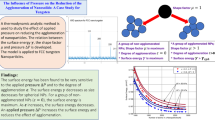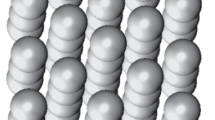Abstract
A simple and general method has been developed to calculate the surface free energy of crystalline tungsten nanoparticles [NP] and nanostructures [NS]. The model takes into account the size, structure, and shape of nanosolids (NPs/NSs). The size-dependent volume and surface-packing fractions are also considered. Both NPs and NSs show size, structure, and shape dependence of the surface free energy (SFE, \(\gamma\)). \(\gamma\) decreases as the size decreases for spherical NP. As the shape is deformed from spherical, \(\gamma\) shows opposite behaviors for NPs and NSs, where it increases for NSs. The model also suggests a novel, theoretical method to predict the structural transition in elements from BCC to FCC or vice versa. As a study case, the model has been applied to tungsten (W). The SFE of a W spherical NP of 0.192 eV/Å2 has been found to drop to 0.150 eV/Å2 at ultrasmall size for both FCC and BCC. On the other hand, the SFE increases to values ranging between 0.18 to 0.20 eV/Å2 for shape deformation factors ranging between 1.512 and 2.936. The results were compared with previous theoretical predictions for other transition metals and show a complete agreement with the general behavior of this study for tungsten spherical and non-spherical nano-tungsten.
Graphical Abstract





Similar content being viewed by others
Data availability
No new data were created or analyzed in this study.
References
Tolias P, the EUROfusion MST1 Team (2017) Analytical expressions for thermophysical properties of solid and liquid tungsten relevant for fusion applications. Nucl Mater Energy 0:1–16. https://doi.org/10.1016/j.nme.2017.08.002
Abdul-Hafidh Esam H, Brahim A (2016) A theoretical prediction of the paradoxical surface free energy for FCC metallic nanosolids. Appl Surf Sci 379:411–414. https://doi.org/10.1016/j.apsusc.2016.04.102
Bao-Qin Fu, Liu W, Li Z-L (2009) Calculation of the surface energy of bcc-metals with the empirical electron theory. Appl Surf Sci 255:8511–8519. https://doi.org/10.1016/j.apsusc.2009.06.002
Yan-Ni W, Jian-Min Z (2008) Surface energy calculation of the bcc metals by using the MAEAM. Comput Mater Sci 42:281–285. https://doi.org/10.1016/j.commatsci.2007.07.016
Wang SG, Tian EK, Lung CW (2000) Surface energy of arbitrary crystal plane of bcc and fcc metals. J Phys Chem Solids 61:1295–1300. https://doi.org/10.1016/S0022-3697(99)00415-1
Zhang J-M, Wang D-D, Xu K-W (2006) Calculation of the surface energy of bcc transition metals by using the second nearest–neighbor modified embedded atom method. Appl Surf Sci 252:8217–8222. https://doi.org/10.1016/j.apsusc.2005.10.043
Pitts RA et al (2019) Physics basis for the first ITER tungsten divertor. Nucl Mater Energy 20:100696–100721. https://doi.org/10.1016/j.nme.2019.100696
Kim HK, Huh SH, Park JW, Jeong JW, Lee GH (2002) The cluster size dependence of thermal stabilities of both molybdenum and tungsten nanoclusters. Chem Phys Lett 354:165–172. https://doi.org/10.1016/S0009-2614(02)00146-X
Xia Yu, Nelli D, Ferrando R, Yuan J, Li ZY (2021) Shape control of size-selected naked platinum Nanocrystals. Nat Commun 12:3019. https://doi.org/10.1038/s41467-021-23305-7
Nellia D, Roncagliaa C, Minnai C (2023) Strain engineering in alloy nanoparticles. ADV PHYS: X 8(1):2127330. https://doi.org/10.1080/23746149.2022.2127330
Abdul-Hafidh EH, Aïssa B (2020) Surface atomic packing fraction as a figure of merit for the structural transition and the bulk-to-nano transformation of spherical FCC and BCC nanosolids. Physica E 120:114015–114023. https://doi.org/10.1016/j.physe.2020.114015
Tyson WR (2013) Surface energies of solid metals. Can J Metall Mater Sci 14(4):307–314. https://doi.org/10.1179/000844375795049997
Kittel C (1996) Introduction to Solid State Physics (Wiley, New York), 7thed
Qi WH, Wang MP, Xu GY (2003) The particle size dependence of cohesive energy of metallic nanoparticles. Chemical Phys Lett 372:632–634. https://doi.org/10.1016/S0009-2614(03)00470-6
Martin CR (1994) Nanomaterials: a membrane-based synthetic approach. Science 266(5193):1961–1965. https://doi.org/10.1126/science.266.5193.1961
Puntes VF, Krishnan KM, Alivisatos AP (2001) Colloidal nanocrystal shape and size control: the case of cobalt. Science 291:2115. https://doi.org/10.1126/science.1058495
Chen S, Fan Z, Carrol DL (2002) Silver nanodisks: synthesis, characterization, and self-assembly. J Phys Chem B 106:10777. https://doi.org/10.1021/jp026376b
Me’traux GS, Cao YC, Jin R, Mirkin CA (2003) Triangular nanoframes made of gold and silver. Nano Lett. 3:519–522. https://doi.org/10.1021/nl034097+
Maillard M, Huang P, Brus L (2003) Silver nanodisk growth by surface plasmon enhanced photoreduction of adsorbed [Ag+]. Nano Lett 3:1611–1615. https://doi.org/10.1021/nl034666d
Gu QF, Krauss G, Steurer W, Gramm F, Cervellino A (2008) Unexpected high stiffness of Ag and Au nanoparticles. Phys Rev Lett 100:045502. https://doi.org/10.1103/PhysRevLett.100.045502
Xiong S, Qi W, Cheng Y, Huang B, Wang M, Li Y (2011) Universal relation for size dependent thermodynamic properties of metallic nanoparticles. Phys Chem Chem Phys 13:10652–10660. https://doi.org/10.1039/C0CP90161J
Fathi A, Ahmed A (2014) Surface free energy of alkali and transition metal nanoparticles. Appl Surf Sci 314:308–313. https://doi.org/10.1016/j.apsusc.2014.07.004
Acknowledgements
The author acknowledges the financial and technical support from Taibah University. The author would like to thank Mr. Yahya Donald for his valuable help and support.
Author information
Authors and Affiliations
Corresponding author
Ethics declarations
Ethical approval
Not applicable.
Conflict of interest
The author declare no conflict to declare.
Additional information
Publisher's note
Springer Nature remains neutral with regard to jurisdictional claims in published maps and institutional affiliations.
Rights and permissions
Springer Nature or its licensor (e.g. a society or other partner) holds exclusive rights to this article under a publishing agreement with the author(s) or other rightsholder(s); author self-archiving of the accepted manuscript version of this article is solely governed by the terms of such publishing agreement and applicable law.
About this article
Cite this article
Abdul-Hafidh, E.H. Surface free energy and structural transition of tungsten nanosolid. J Nanopart Res 24, 266 (2022). https://doi.org/10.1007/s11051-022-05638-6
Received:
Accepted:
Published:
DOI: https://doi.org/10.1007/s11051-022-05638-6




